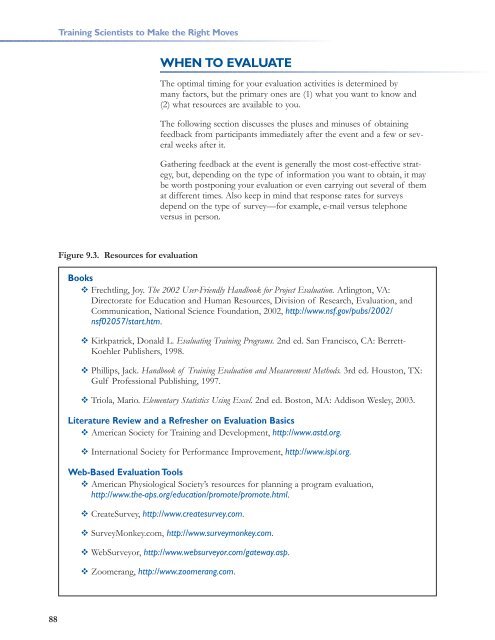Training Scientists to Make the Right Moves - Howard Hughes ...
Training Scientists to Make the Right Moves - Howard Hughes ...
Training Scientists to Make the Right Moves - Howard Hughes ...
You also want an ePaper? Increase the reach of your titles
YUMPU automatically turns print PDFs into web optimized ePapers that Google loves.
<strong>Training</strong> <strong>Scientists</strong> <strong>to</strong> <strong>Make</strong> <strong>the</strong> <strong>Right</strong> <strong>Moves</strong><br />
WHEN TO EVALUATE<br />
The optimal timing for your evaluation activities is determined by<br />
many fac<strong>to</strong>rs, but <strong>the</strong> primary ones are (1) what you want <strong>to</strong> know and<br />
(2) what resources are available <strong>to</strong> you.<br />
The following section discusses <strong>the</strong> pluses and minuses of obtaining<br />
feedback from participants immediately after <strong>the</strong> event and a few or several<br />
weeks after it.<br />
Ga<strong>the</strong>ring feedback at <strong>the</strong> event is generally <strong>the</strong> most cost-effective strategy,<br />
but, depending on <strong>the</strong> type of information you want <strong>to</strong> obtain, it may<br />
be worth postponing your evaluation or even carrying out several of <strong>the</strong>m<br />
at different times. Also keep in mind that response rates for surveys<br />
depend on <strong>the</strong> type of survey—for example, e-mail versus telephone<br />
versus in person.<br />
Figure 9.3. Resources for evaluation<br />
Books<br />
Frechtling, Joy. The 2002 User-Friendly Handbook for Project Evaluation. Arling<strong>to</strong>n, VA:<br />
Direc<strong>to</strong>rate for Education and Human Resources, Division of Research, Evaluation, and<br />
Communication, National Science Foundation, 2002, http://www.nsf.gov/pubs/2002/<br />
nsf02057/start.htm.<br />
Kirkpatrick, Donald L. Evaluating <strong>Training</strong> Programs. 2nd ed. San Francisco, CA: Berrett-<br />
Koehler Publishers, 1998.<br />
Phillips, Jack. Handbook of <strong>Training</strong> Evaluation and Measurement Methods. 3rd ed. Hous<strong>to</strong>n, TX:<br />
Gulf Professional Publishing, 1997.<br />
Triola, Mario. Elementary Statistics Using Excel. 2nd ed. Bos<strong>to</strong>n, MA: Addison Wesley, 2003.<br />
Literature Review and a Refresher on Evaluation Basics<br />
American Society for <strong>Training</strong> and Development, http://www.astd.org.<br />
International Society for Performance Improvement, http://www.ispi.org.<br />
Web-Based Evaluation Tools<br />
American Physiological Society’s resources for planning a program evaluation,<br />
http://www.<strong>the</strong>-aps.org/education/promote/promote.html.<br />
CreateSurvey, http://www.createsurvey.com.<br />
SurveyMonkey.com, http://www.surveymonkey.com.<br />
WebSurveyor, http://www.websurveyor.com/gateway.asp.<br />
Zoomerang, http://www.zoomerang.com.<br />
88
















